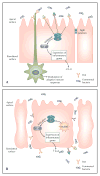Commensal bacteria and epithelial cross talk in the developing intestine
- PMID: 17991339
- PMCID: PMC3208513
- DOI: 10.1007/s11894-007-0047-7
Commensal bacteria and epithelial cross talk in the developing intestine
Abstract
Indigenous intestinal microbes have co-evolved with the intestinal immune system to form a symbiotic ecosystem. In the postnatal period, intestinal microbes provide the developing gut with stimuli that are necessary for healthy maturation of the intestinal immune system. Cross talk between the host and commensal microbes is an essential component of gut homeostasis mechanisms also in later life. During recent years, innovative research has shed light on the molecular mechanisms of these interactions.
Figures

Similar articles
-
Innate immune relationship between commensal flora and the mammalian intestinal epithelium.Cell Mol Life Sci. 2005 Jun;62(12):1339-48. doi: 10.1007/s00018-005-5038-y. Cell Mol Life Sci. 2005. PMID: 15971109 Free PMC article. Review.
-
The habitat, double life, citizenship, and forgetfulness of IgA.Immunol Rev. 2012 Jan;245(1):132-46. doi: 10.1111/j.1600-065X.2011.01072.x. Immunol Rev. 2012. PMID: 22168417 Review.
-
Has the microbiota played a critical role in the evolution of the adaptive immune system?Science. 2010 Dec 24;330(6012):1768-73. doi: 10.1126/science.1195568. Science. 2010. PMID: 21205662 Free PMC article. Review.
-
Interaction Between Commensal Bacteria, Immune Response and the Intestinal Barrier in Inflammatory Bowel Disease.Front Immunol. 2021 Nov 11;12:761981. doi: 10.3389/fimmu.2021.761981. eCollection 2021. Front Immunol. 2021. PMID: 34858414 Free PMC article. Review.
-
Innate and adaptive immunity cooperate flexibly to maintain host-microbiota mutualism.Science. 2009 Jul 31;325(5940):617-20. doi: 10.1126/science.1172747. Science. 2009. PMID: 19644121 Free PMC article.
Cited by
-
A novel mouse model of inflammatory bowel disease links mammalian target of rapamycin-dependent hyperproliferation of colonic epithelium to inflammation-associated tumorigenesis.Am J Pathol. 2010 Feb;176(2):952-67. doi: 10.2353/ajpath.2010.090622. Epub 2009 Dec 30. Am J Pathol. 2010. PMID: 20042677 Free PMC article.
-
From raw milk cheese to the gut: investigating the colonization strategies of Bifidobacterium mongoliense.Appl Environ Microbiol. 2024 Sep 18;90(9):e0124424. doi: 10.1128/aem.01244-24. Epub 2024 Aug 16. Appl Environ Microbiol. 2024. PMID: 39150265 Free PMC article.
-
Academy of Breastfeeding Medicine founder's lecture 2008: breastfeeding--an extrauterine link between mother and child.Breastfeed Med. 2009 Mar;4(1):3-10. doi: 10.1089/bfm.2009.0004. Breastfeed Med. 2009. PMID: 19292608 Free PMC article. Review.
-
Colonization and Succession within the Human Gut Microbiome by Archaea, Bacteria, and Microeukaryotes during the First Year of Life.Front Microbiol. 2017 May 2;8:738. doi: 10.3389/fmicb.2017.00738. eCollection 2017. Front Microbiol. 2017. PMID: 28512451 Free PMC article.
-
Cesarean versus vaginal delivery: long-term infant outcomes and the hygiene hypothesis.Clin Perinatol. 2011 Jun;38(2):321-31. doi: 10.1016/j.clp.2011.03.008. Clin Perinatol. 2011. PMID: 21645799 Free PMC article. Review.
References
-
- Rautava S, Kalliomaki M, Isolauri E. New therapeutic strategy for combating the increasing burden of allergic disease: Probiotics-A Nutrition, Allergy, Mucosal Immunology and Intestinal Microbiota (NAMI) Research Group report. J Allergy Clin Immunol. 2005;116:31–37. - PubMed
-
- Schnare M, Barton GM, Holt AC, et al. Toll-like receptors control activation of adaptive immune responses. Nat Immunol. 2001;2:947–950. - PubMed
-
- Kaisho T, Akira S. Toll-like receptor function and signaling. J Allergy Clin Immunol. 2006;117:979–987. - PubMed
-
- Akira S, Uematsu S, Takeuchi O. Pathogen recognition and innate immunity. Cell. 2006;124:783–801. - PubMed
Publication types
MeSH terms
Grants and funding
LinkOut - more resources
Full Text Sources
